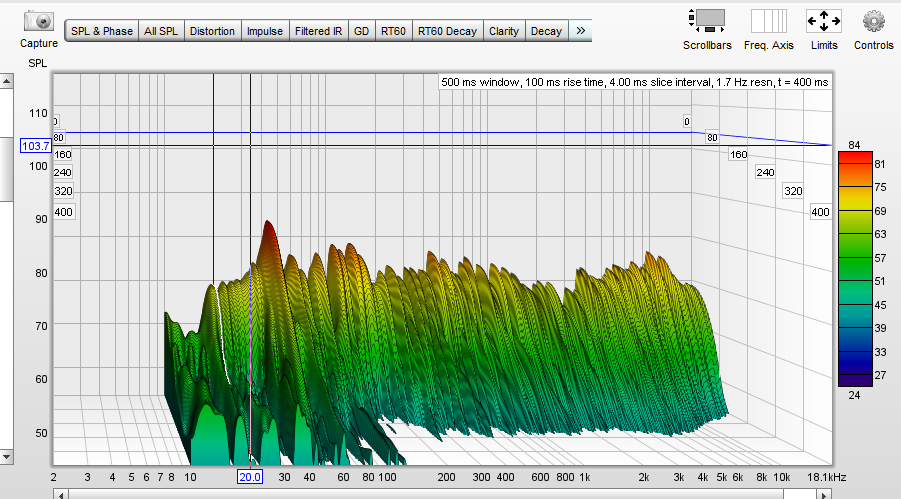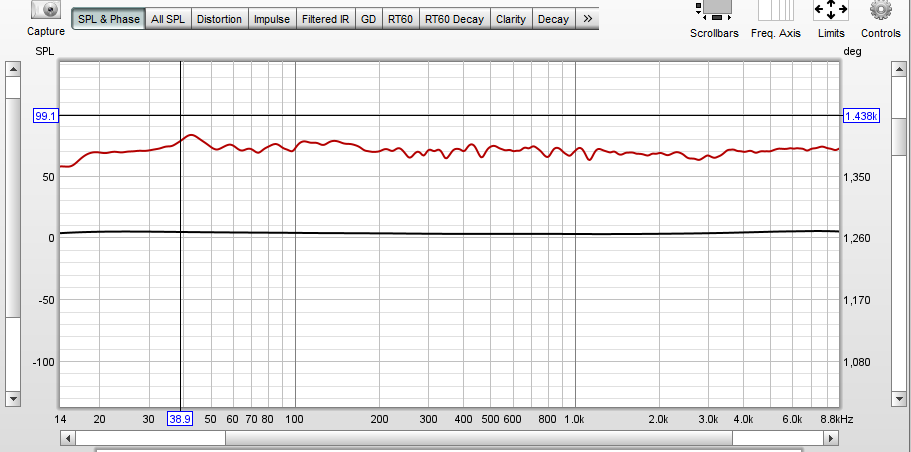@bobpyle, not all Bob. I referenced baclagg's frequency response curve. I know what my preferences are relative to a flat response curve because I have the capability of making my system perfectly flat or whatever I want it to be. My ears are not the reference but I know what ear likes to hear and the rest of me wants feel. I can replicate what I want to hear without ever listening to music just by measuring frequency sweeps an making adjustments according to what I hear but what I see.
Shouldn't This Sound Boomy?
I have recently purchased a mic and I’m running REW to test my room response. These are the resulting charts:


I hear nice tight bass when I play music. I hear a big improvement over my previous speakers. The mid range and treble sound great and again the bass sounds articulate and tight. I would think this would be boomy and muddled. Unfortunately, I did not have the ability to test my previous speakers. The room is treated with GIK panels, but I have no bass traps in the corners due to the spouse approval factor. Am I a horrible listener that can’t hear this, or am I missing something else?
Showing 6 responses by mijostyn
@bobpyle , unfortunately Bob, your ears do not a reference point make. You can not tell someone how to make their system sound like you want to hear. What is it that you want to hear? Well perhaps you like your system a little brighter. What does that mean. You can not say. None of this, except the way I tune my system to my taste is an opinion of mine. It is an approach that all serious professionals use. And you always start from a reference point and that reference point is a flat amplitude response across the entire audio spectrum. The technology to manage audio systems was not available to us back in the day. I got my first record player in 1958 and it had a tonearm that looked like a cobra and even had eyes painted on it! Getting anything to sound right was a hit or miss proposition. People still behave as if this is still the case. It is not. With the right tools one can make almost any system (includes the room) sound good, maybe not great but in many instances surprisingly good. There are some rooms and situations that are totally hopeless but they are relatively few. The situations that are fantastic are also relatively rare, I am talking about rooms that were specifically designed for audio reproduction with speakers like your if you are a point source kind of guy or mine if you are into line source dipoles. You can never trust anyone's ears. People tend to like what they are use to listening to. To a person whose system is falsely bright a system that is correct will sound dull. If a person tells me he likes his treble advanced 3 dB/oct from 10kHz I know exactly what he means and can even imagine it. I can make almost any system sound the way I like without ever playing any music. If I analyzed your system I could tell you exactly what you are listening to, not my opinion of what you are listening to. |
@bobpyle ,the Q5s are a great speaker. Magico is perhaps my favorite dynamic speaker manufacturer. The Q series subwoofers are the best commercial subwoofers available sonically just way too big for my situation. They need to design smaller versions for use in multiples. Tuning a system to the taste of the individual is the final step in setting up a system. Measuring the system like @baclagg has done is the first step. Getting the system flat and balanced with room treatment and digital signal processing is the middle step. Because I handle it this way I can tell you exactly what I want to hear and why. You may want to hear something different. OK, what? Can anyone here draw me the amplitude response of a system tuned to their taste? How many here know exactly what their system is doing? Most people just make assumptions. They do not measure. Consequently there is no way they can optimize the performance of their systems. Many add silly "tweaks" in a vain attempt at improving performance wasting the money they could have spent on a good measurement microphone and computer program. |
@bobpyle , you need to attend smaller venues like the Blue Note in NYC and The Regata Bar in Boston. Rock concerts are Mono PA sound are worthless for evaluating home system. Fortunately, most live recordings are taken off the sound board and mixed like any other recording. Lifelike sounding bass is lifelike whether you like it or not. If you don't like it you do not belong here. I suggest you visit a Bose Forum actually that is not fair to Bose. You should find a forum that talks about computer speakers. Those do not have much bass. Just your speed.
|
@baclagg , This looks more like I would expect. By 28 Hz your bass is down 15dB. To give you the feel of a live performance you want you bass up 5 to 10 dB between 20 and 30 Hz. This is what subwoofers are for. At 200 Hz there is a 7 dB variation between channels. This is probably the wall. Middle C is 254 H. This will mess up your image a bit. Otherwise the speakers track each other very nicely. So the image is not going to be bad at all but it could be better. The overall curve is downsloping to 2200 hz which is down 15 dB from baseline. This will lead to a darker more forward presentation. Easy to listen to but not entirely accurate. You can play around above 10 kHz and below 100 Hz without changing the staging but between 100 Hz and 10 kHz you want absolutely flat in both channels. Now that you are measuring you have to gain the ability to do something about it. That something would be digital signal processing and the ability to EQ each channel individually. Digital preamp/processors like the DEQX, Anthem, Trinnov and MiniDSP units give you that capability. After you listen to a flat system for a while you can get a feel for what any system is doing just by listening. You also learn what your preferences are and how to make any system sound the way you like. I boost bass by 3dB/oct below 100 Hz. It gives you the feel of a live concert at more reasonable levels. I ramp the treble up 6 dB/oct above 12 kHz to make up for my older hearing. A younger person may not like this. |
Good for you! If you move around the room with the Mic you will notice the bass response changing. The peak at 25 Hz will move around. The lumpiness below 100 Hz is due to room interaction. Actually, you are not too bad. Where was the Mic positioned? You should take all measurements from the listening position. Next you need to run curves on each speaker individually. Ideally their response should be exactly the same. Post the results and we can talk about it.
|

